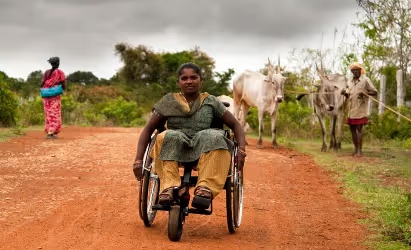Appropriate and affordable emergency wheelchairs

Project overview
Project solution
This project offers [specific solution or intervention] to tackle [challenge]. By implementing [strategies, tools, or innovations], the project aims to achieve [desired outcomes]. The approach is designed to [specific actions or methods] to bring about meaningful change in [community, region, or issue area].
Expected outcomes
This project aims to achieve [specific outcomes], such as [measurable results, improvements, or changes]. The expected impact includes [benefits to the target community, advancements in research or innovation, or long-term effects]. By the end of the project, we anticipate [specific changes or milestones] that will contribute to [broader goals or objectives].
Summary: International agencies such as Handicap International report that there are no appropriate wheelchairs currently available to meet the needs of people who are injured or have lost their existing wheelchair in an emergency situation. This means that they are one of the most vulnerable groups: immobile, excluded from relief efforts, dependent on others and at risk of life-threatening health complications. Appropriate, affordable, lightweight, ‘emergency wheelchairs’ are essential in the immediate aftermath of a disaster. They offer a temporary solution upon which longer term, sustainable wheelchair provision can develop. An innovative wheelchair will therefore be designed specifically to meet this need which is not currently being met by any other product. In contrast to the majority of orthopaedic wheelchairs that are donated in emergencies, its specifications will make it suitable for such environments, while also meeting international standards. The emergency wheelchair will allow high numbers of victims of an emergency situation to access relief services and have a greater chance of survival.
Challenge(s) addressed:
- In emergencies wheelchairs are typically slow to arrive, second hand, hospital chairs which rarely meet international standards and are not designed for the challenging environments typical of emergencies
- The lack of suitable wheelchairs in emergency settings causes life threatening situations for injured and disabled people and excludes them from emergency relief efforts
Innovation Factor: There is no other wheelchair which meets the specific requirements of emergency situations; this will be an innovative product specifically designed to be appropriate and supplied quickly.
Added Value: Motivation and Handicap International will work together with their unique and complementary expertise; Motivation in the field of wheelchair design and provision, and Handicap International in the field of emergency relief.
Innovation Phases Description:Recognition:
- Identify design specification for emergency wheelchair
- Evaluate existing products and design development
Invention:
- Produce prototypes of wheelchairs
- Trial prototypes
- Finalise design
- Identify and define tools and training
- Design, develop and prototype tools and training
Key Deliverables / Impact:
- Lives are saved; injured and disabled people survive and are included in emergency relief efforts
- The sector is able to rapidly and effectively meet the needs of injured and disabled people in emergency situations, changing international practice
Project delivery & updates
Stay up to date with the latest developments from this project. Here, you will find details on what has been delivered, resources created, and regular updates as the project progresses. Access key documents, reports, and other materials to see how the project is making an impact.